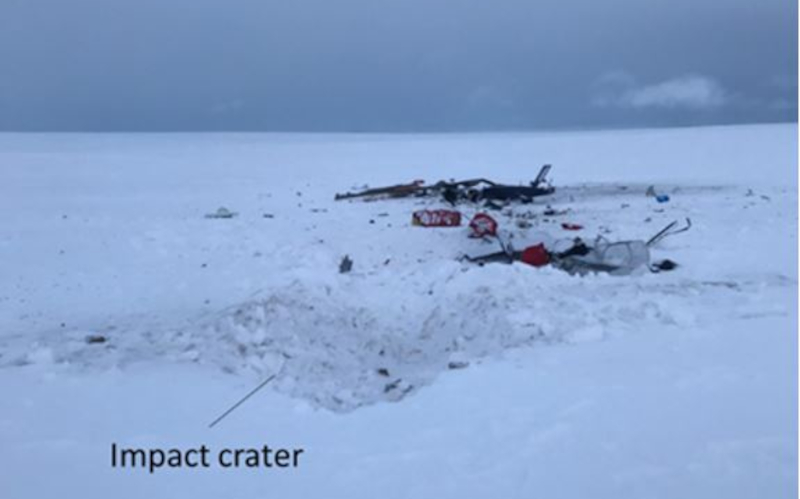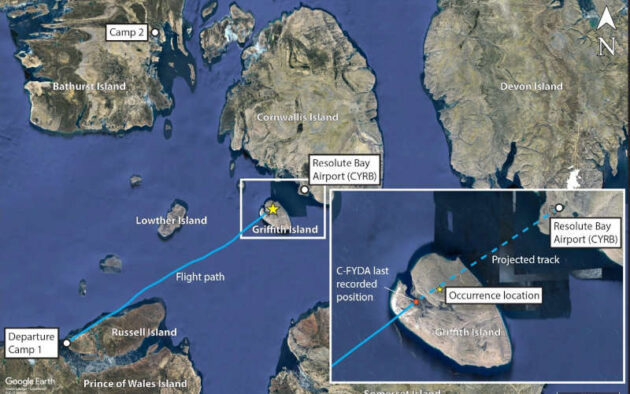
Features
Accidents
TSB releases report, recommendations based on deadly 2021 helicopter crash in Nunavut
February 15, 2024 By Helicopters Staff
 Photo of the crash site taken the day of the occurrence. (Source: RCMP/Transportation Safety Board of Canada)
Photo of the crash site taken the day of the occurrence. (Source: RCMP/Transportation Safety Board of Canada) The Transportation Safety Board of Canada in its investigation report (A21C0038) found that insufficient regulatory requirements and defences to protect against loss of visual reference accidents led to the fatal 2021 crash of an Airbus AS350 helicopter on Griffith Island, Nunavut. Based on its findings, the Transportation Safety Board of Canada (TSB) issued four recommendations to the regulator, Transport Canada.
On April 25, 2021, the incident helicopter, operated by Great Slave Helicopters 2018 Ltd., was returning to Resolute Bay, Nunavut, when it collided with terrain killing all three on board – the pilot, an aircraft maintenance engineer, and a biologist.

Occurrence flight track, with inset magnification of occurrence location and projected track (Source of both images: Google Earth, with TSB annotations based on the aircraft’s satellite flight-tracking system position data)
The investigation found that as the helicopter approached the highest elevation on Griffith Island, the uniformly snow-covered and featureless terrain, an overcast sky, and snow squalls likely created flat light and whiteout conditions. TSB explains this led to an unexpected loss of visual reference to the horizon, also known as inadvertent flight into instrument meteorological conditions (inadvertent IMC). While the pilot was likely attempting to visually manoeuvre the helicopter in response to inadvertent flight into IMC, TSB explains an unintentional descent resulted in the helicopter colliding with terrain.
“For more than 30 years, the TSB has been calling for the implementation of safety measures to mitigate the risks that persist in helicopter reduced visibility operations.’’ said Kathy Fox, TSB Chair. “These are systemic safety issues that continue to put at risk the lives of thousands of pilots and passengers every year.’’
The TSB explains that its investigation determined that currently there are no regulatory requirements for commercial helicopter operators to ensure that pilots have the training and technology required to be able to recover from an inadvertent flight into IMC. The TSB also notes single-pilot operators (either helicopter or airplanes) are not required to have standard operating procedures, which the safety board explains would provide pilots with pre-determined successful solutions for specific situations that may be encountered, including an inadvertent flight into IMC.
TSB research has found that although “loss of visual reference” accidents are more than twice as likely to involve helicopters than airplanes, requirements for helicopters are less stringent. These differences permit helicopters to operate at half the visibility applicable to airplanes, explains the TSB, but without the same level of defences.
As a result, TSB issued the following four recommendations calling on Transport Canada to:
require commercial helicopter operators to ensure pilots possess the skills necessary to recover from inadvertent flight into IMC. [A24-01]
require commercial helicopter operators to implement technology that will assist pilots with the avoidance of, and recovery from, inadvertent flight into IMC. [A24-02]
require private and commercial operators conducting single-pilot operations to develop standard operating procedures based on corporate knowledge and industry best practices to support pilot decision-making. [A24-03]
enhance the requirements for helicopter operators that conduct reduced-visibility operations in uncontrolled airspace to ensure that pilots have an acceptable level of protection against inadvertent flight into IMC accidents. [A24-04]
Following the accident, TSB notes Great Slave Helicopters implemented numerous safety actions, including: Amending standard operating procedures, revising and updating pilot training, implementing new procedures, and establishing quarterly safety management meetings.
The TSB has identified loss of spatial awareness in 13 investigations involving commercial helicopter flights conducted between 2010 and 2018 and has issued 10 recommendations to Transport Canada aimed at preventing inadvertent IMC accidents.
View the full TSB report.